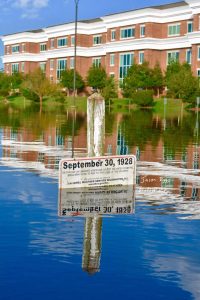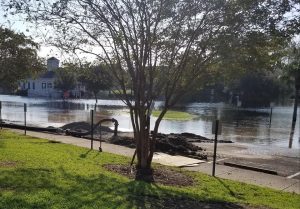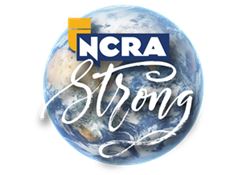
By Bobbi Fisher
On September 10, Hurricane Florence made her presence known on the weather radar with an alarming size. Forecasters predicted a strong Category 4 hurricane was headed toward the Wilmington, N.C., area – to include where I live and work as an official reporter in Myrtle Beach, S.C.
Mandatory evacuations began for our area on Tue., Sept. 11. Mandatory evacuation means, if you choose to stay, you do so at your own risk; rescue attempts, if needed, may not be possible. Since we have only lived here for three years, we checked with our seasoned neighbors to see if they were going to evacuate or stay. Our angst grew when they told us they would leave for this projected monster of a storm.
Facebook Live is a wonderful tool to use to get live local weather updates without having to stay glued to a television. If you “like” your local news channel, they will send you notifications when live feeds are about to start so you can tune in. It also offers an opportunity to actually chat with your meteorologist to ask specific questions. I find it a wonderful tool for emergency planning.
With the generator fueled and ready to go and a few trips to the grocery store to stock up on cases of water and food supplies, we decided we would stay home and ride it out. We live about three miles from the oceanfront but far enough inland where storm surge wouldn’t really affect us.

I am an official reporter for Family Court in Horry County (Conway/Myrtle Beach). My husband also works in the same courthouse building with me but for the Clerk of Court’s office. We had one hearing scheduled for Tuesday morning, so as I was heading in to court, my judge called me and told me to turn around and go home. By then, roads had already started to close and I wasn’t able to turn around where I was in the road because they literally had just put up barricades. I had to make a huge loop north and then turn back south to get back home. Roads were starting to shut down literally as the minutes were ticking away.
After returning home that morning, we started to watch The Weather Channel to track Hurricane Florence. They were now projecting it would come to Wilmington then turn a sharp southwest, heading straight over our house. It was then we decided we better evacuate to our family in Northern Virginia. This began the task of packing everything we could. We have two pit bulls, so we decided to take both of our cars – one dog in each car.
Along with the normal clothing items for the next seven days, I packed up my reporting equipment. I had just purchased a new Luminex writer the week prior, so that was the very last thing to go in the car. Along with my writer, I packed up a separate bag with my laptop and my external hard drives (now I’ve converted to Dropbox). I left my hard copy court dockets in the filing cabinet because I scan all of those anyway. I made sure that any other papers and equipment were high enough off the ground in case we did have water inside our home. As a reporter, even in time of crisis, you must consider securing your equipment and your files the best way you can.
As we started planning our evacuation, another fear was making sure we would have enough fuel to make the six-hour trek through the Carolinas to get back to Virginia, as thousands of people were fleeing for safety and we weren’t sure of the gas situation along our route. In fact, I ended up calling ahead just to make sure at least one station had enough fuel in their tanks for us to refuel. We left at 4 a.m., and even at that hour, our local police were monitoring every intersection. The lane reversal was in effect, which meant that all lanes were only running westbound. It was a pretty neat experience to be driving on the wrong side of the road!
There are two major ways in to the Myrtle Beach area: the 501 Bypass, which runs in front of Lake Busbee; and the 501 Business, which runs through the historic town of Conway. Traffic also has to pass over an old bridge in Conway that is scheduled to have major repairs done in the next few months, so a lot of people were very worried about whether the bridge would even hold up for this amount of traffic, which included tractor trailers and heavy equipment trucks.
The Waccamaw River, which runs through Conway, is the runoff water from the rivers that start in North Carolina, where the hurricane dumped several inches of rain. The National Guard quickly started dumping huge piles of sand and dirt and massive sandbags to create a dam on the 501 Bypass so we did not lose our main highway. Helicopters flew overhead delivering sandbag after sandbag to the nearby cold ash reserve to try to contain the pond waters from seeping into the Waccamaw River flood waters.
Even 10 days after the hurricane, we waited for our rivers to crest and recede. Hundreds of people were frantically packing their belongings to try to save what they could, and it would take many, many days before those homeowners would be able to return to assess their damage.

It would take a few days before the flooding would crest locally for us, so at least we had time to prepare. Court ended up being closed from Tues., Sept. 1, through Mon., Sept. 18.
When the waters started rising at the courthouse, the court reporter parking spaces became filled with up to three (or more) feet of water, and then the waters started to encroach on the judge’s parking area as well. The reserved court reporter spaces where I normally park were now busted up to install huge drainage equipment.
Downtown Conway looked like a war zone. With the water rising, many streets were impassable and closed, leaving you to try to figure out how to maneuver around town. The Waze app is another tool that many people used to get around during the storm. Because the roads were closing by the minute, the Waze app had real-time information on which roads were open and would direct you that way.
Several hundred homes were flooded as a result of the overflowing rivers. Along I-40 in North Carolina, hundreds of dead fish littered the highway after the waters receded. Displaced animals could be seen trying to survive the waters: A crocodile was seen swimming at the local dog park. Eels and snakes were now inside people’s homes. Fire ants built “chain” bridges and floated on top of the water. One of our court clerks even captured video of a wild hog swimming through the flood waters in the back of the courthouse and walking out next to her window.
Once the mandatory evacuations had been lifted and we were allowed to return to our homes, we began the quest to figure out how to get home. With many, many miles of highway along I-95 in North Carolina and South Carolina under water, we decided to go west, then south, then circle back east; a trip that would take us 11 hours compared to our normal six-hour route.
For us in the Myrtle Beach area, it wasn’t so much the wind damage but the flooding as a result of the North Carolina rivers that flow downstream to us. Even almost a month later, things still have not returned to normal for us. Many are still displaced from their homes. We’re just getting our local roads back to normal. Schools were out three weeks because of the weather, and many of them were turned into shelters. And now the mosquitos have taken on a life of their own. (I hear they’re pretty big! Almost quarter size!)
There is one thing to say about something this eventful: The community spirit really shines through. There are still so many food/supply drives and fundraising events going on to help those in need. “Carolina Strong” is the motto we live by here, and it really shows in our spirit to overcome and rebuild once again.
Bobbi Fisher, RPR, is an official court reporter from Myrtle Beach, S.C. She also serves as a member of NCRA’s Proofreading Advisory Council.
The National Center for State Courts (NCSC) published an article, “NCSC helps courts prepare for disaster,” in their October 2 bulletin.








